SAO Guest Contribution

SAO Guest Contribution |
 |
Simulating the First Stars in the Universe
Dr. Tom Abel
Dr. Tom Abel is an assistant professor of the Department of Astronomy and Astrophysics at Penn State University. His research interests include the first structures in the universe, re-ionization and radiative transfer in cosmology, quasar absorption line systems, magnetohydrodynamics in the early universe, formation of molecular clouds and globular clusters, chemistry of the early universe, and the first stars. In 2001 he was the awarded the Johann Wempe Prize for a promising young scientist who has already made a notable contribution to their field.
As part of his research, Tom uses supercomputers to study the origin and evolution of cosmic structures, such as the first galaxies and stars in the universe. His work combines a careful understanding of atomic and molecular physics with the nonlinear hydrodynamics of cosmic matter that led to the formation of the first cosmological objects In this Guest Contribution, Tom describes the sophisticated simulations that allow him and his collaborators to examine how stars may have formed in the early epochs of the Universe.
If you have any questions about this Guest Contribution, don't contact Tom directly please. Instead, post them to the Astronomy News forum and we'll put them together & forward them to Tom for comment.
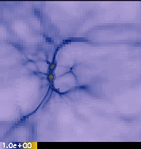
The first thing to realise is that stars are small! A Galaxy is easily one thousand billion times larger than a star. For
the first star in the universe, however, the (micro) galaxy forms
first. Since we do not want to make any simplifying assumptions we
have to follow all these scales. This has become possible only with
the most sophisticated compter programs running on supercomputers. My
collaborator Greg Bryan developed such a program during the time when
we were both graduate students of Mike Norman. We then combined a
little program that describes how molecules form with Greg's code and
started to run the first simulations in 1996. That chemistry module
was what I had worked on for my Masters thesis. After a few years more
on adpapting the code and running larger and larger simulations we have
arrived at an answer what the first stars may be. They are very
massive (somewhere between 50 and 300 times the mass of our sun) and
form in isolation. That means that only one forms in its host
pre-galactic object. We call these small galaxies a 'micro-galaxy' since
they have roughly a millionth (micro) of the mass of our galaxy, the
Milky Way.
A few million years after the Big Bang the matter distribution in the
universe was very smooth.

When we start the simulations at 13 million years after the Big Bang in our model universe there are only some small density fluctuations in the dark matter component (bottom row of the figure above). The gas component (top row in the image above) has harldy any features at these high redshifts. As time goes on some very small dark matter objects collapse because of gravity (see middle panels at redshift 24 = 100 million years after the Big Bang). The gas is attracted by these mass concentration and starts to fall towards them. However, because of gas pressure only the more massive dark matter halos can bind significant amounts of gas.
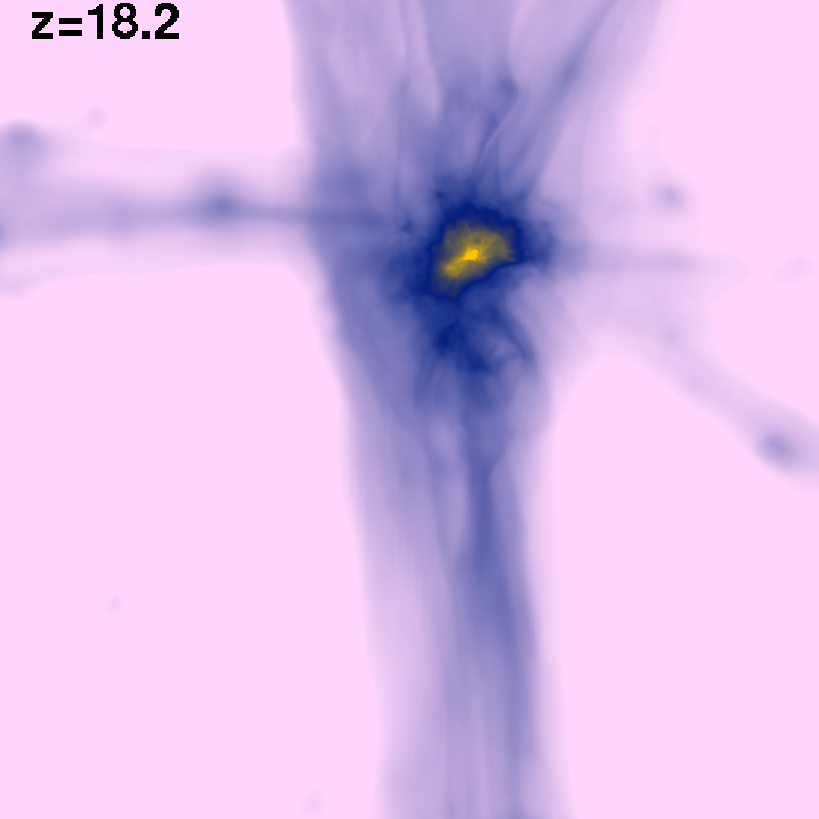
At the final redshift of the simulation, z=18.2, the universe is 155 million years old and one object of one million solar masses has formed a star in its center. Please click on the image to see the associated projection of the dark matter density at a slightly smaller scale.
The images below show thin slices through the three dimensional volume depicting the logarithm base 10 of the gas temperature in Kelvin (so 3 stands for 103 Kelvin) at this final time of the simulation. Please note that the small differences in temperature correspond to quite different colors on the colormap. We do no smoothing here showing the numerical resolution of the adaptive mesh for the last six zooms of ten. Please note that the piecewise parabolic method used to solve the hydrodynamic equations actually has an even smoother representation of the flow. The simulation visualized here and in the temperature section has "only" a dynamic range of 1010.
Please click on the images to see the corresponding density slices.
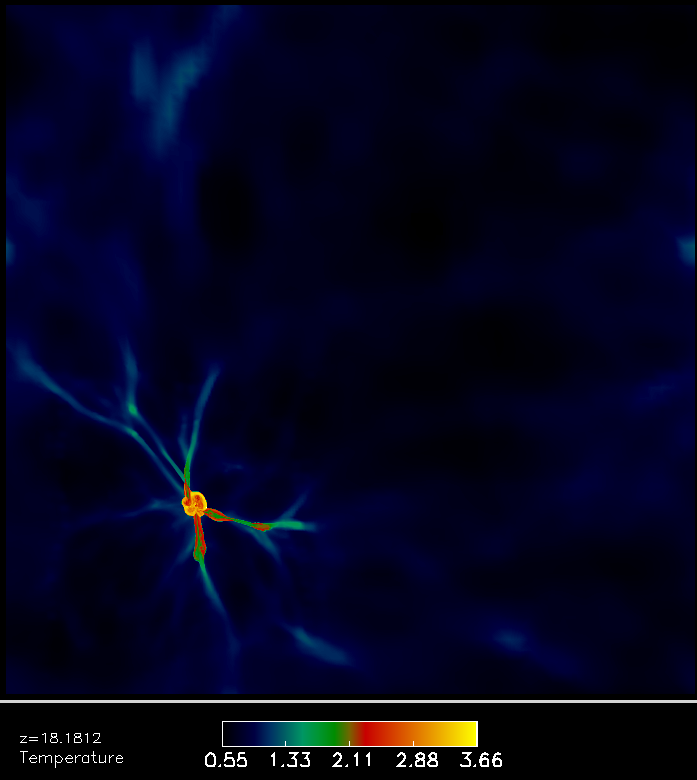
18,000 light years across: Above we see the thin slice of the gas temperature. On the large scale we are cutting through filaments and sheets which are warmer than the average temperature of the universe at that point. This heating comes from the fact that as gravity pulls material together it heats up. This is heating from compression you might have noticed when pumping air in the tires of your bicycle.
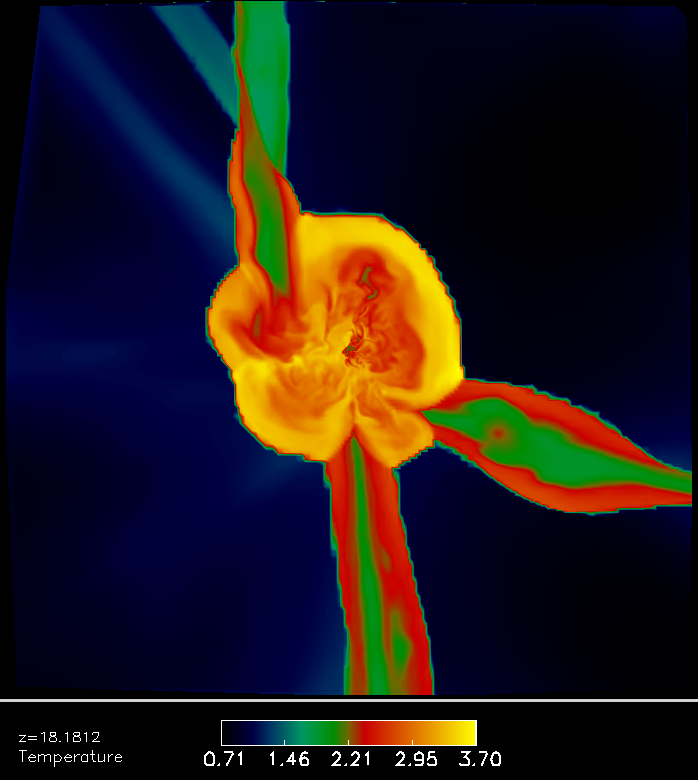
1,800 light years across: At a 10 times smaller scale than the previous image the pre-galactic object within which the first star is born can be seen. It weighs about one million times the mass of our sun. The large temperatures (yelow colors) are achieved as cold gas is falling from the outside into the galaxy. As this infalling gas is slowed down by the pressure of the gas within the galaxy its kinetic energy (i.e. the energy in the infalling motion) is converted into internal energy (temperature increase). Interestingly within the pre-galactic object the temperatures are droping again to a few hundred degrees Kelvin (redish colors). This cooling is a consequence of the radiation given off from molecular hydrogen which has been formed when the temperatures rose.
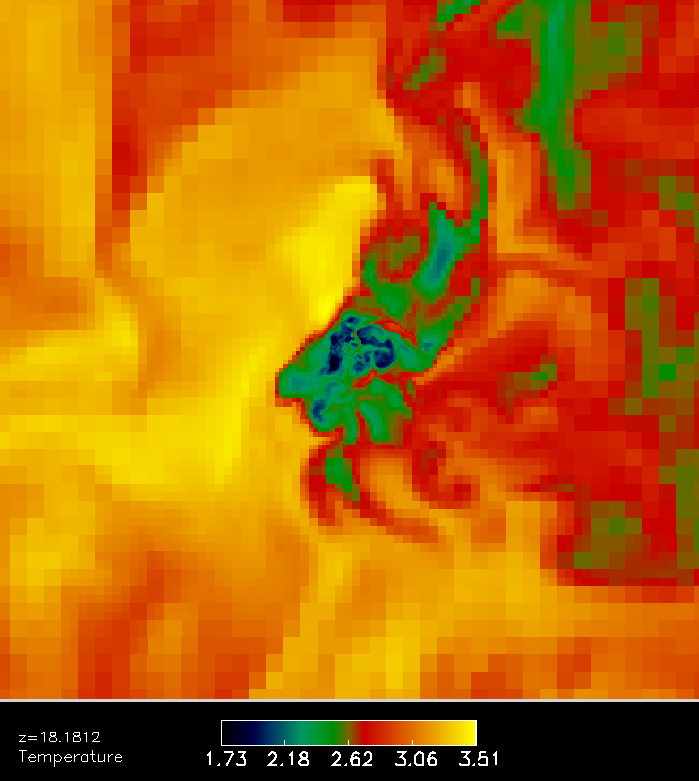
Scale 180 light-years: As we are zooming by another factor 10 we see a cold (approx. 200 degrees Kelvin) dense region (inner green and blue region) which is approximately 30 light years across. This is the high redshift analog of a molecular cloud as similar to the star forming molecular clouds seen in our own galaxy the Milky Way.
18 lightyears across: As we are zooming in further we get a close up view of the "molecular cloud". In fact this molecular cloud does only have a fractional abundance of 1/1000 of hydrogen molecules. The rest is all atomic hydrogen and helium. Galactic molecular clouds on the other hand are fully molecular. Nevertheless the similarities are that molecular clouds are the cold and dense components within stars are formed. Interestingly, although the temperature is these primordial molecular clouds are 10 times larger then the present day analogs they do have comparable sizes. This cloud contains around one thousand solar masses. Interestingly a tiny warm region can be seen in the center...
1.8 lightyears across: A warmer dense core becomes visible as we are zooming in by another factor of ten.
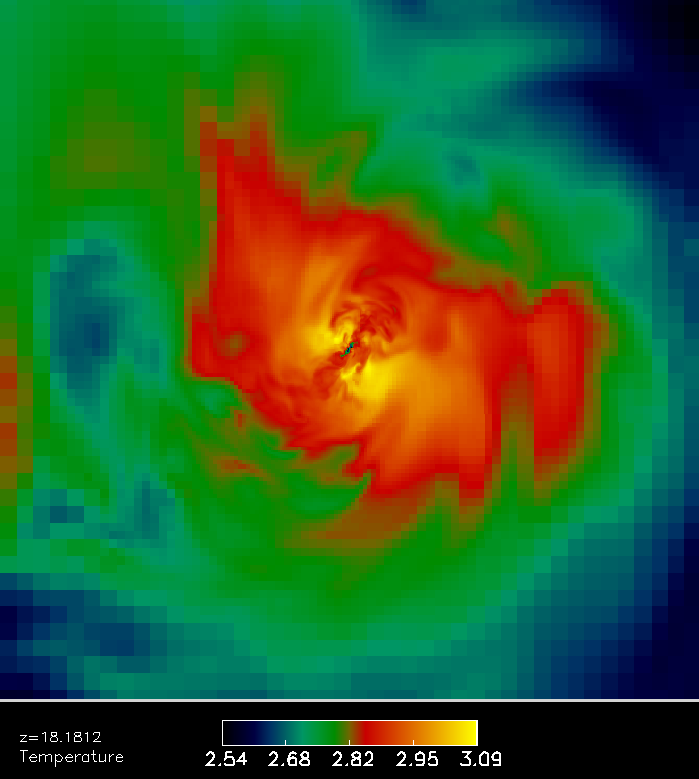
2 lightmonths across: Another factor of ten gives a clearer view of this dense collapsing core. Temperatures have gone up again due to the fast collapse. This core has roughly 200 solar mass. But yet a new effect becomes evident in the center: the temperatures are lower again at the center in an elongated region (from lower left to upper right at the very center) ...
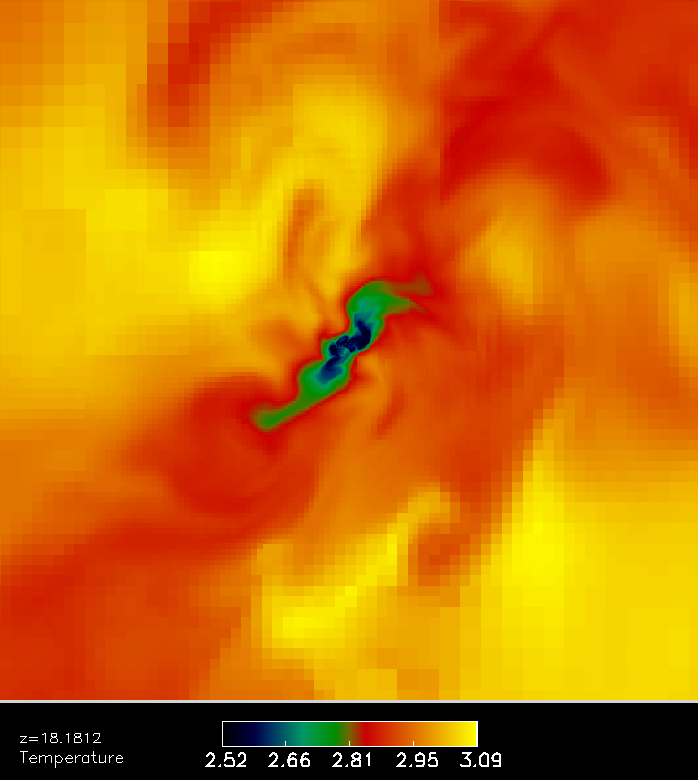
6 light days across: Yet further in we now see an elongated cooler region. This arises from a chemical reaction that only occurs at high densities: three body H2 formation. Here simultaneous collisions of three neutral hydrogen atoms, which are more probable at high than at low densities, sometimes leads two of the neutral hydrogen atoms to combine to a molecule. Consequently, the collapsing gas became fully molecular and was now able to cool (radiate) more efficiently than with fewer molecules.
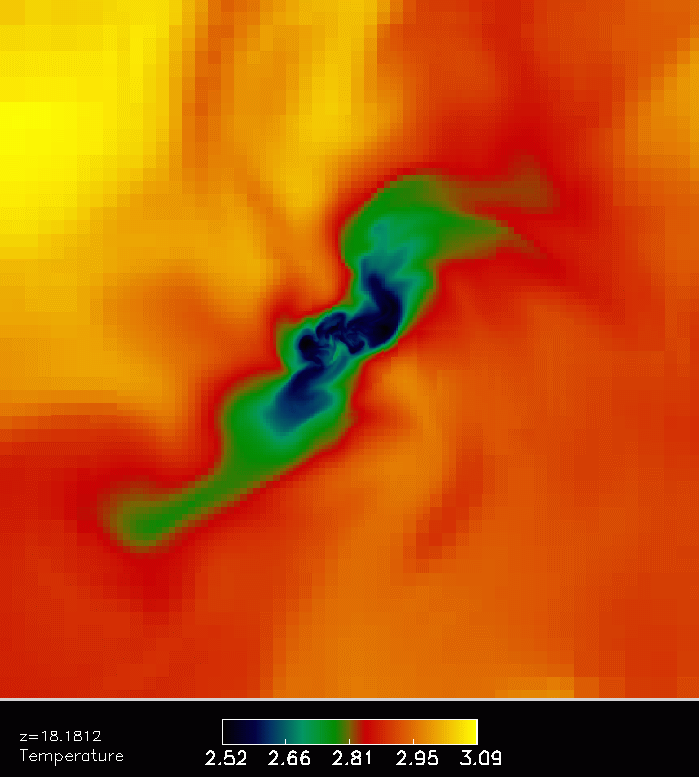
The central cool region is the proto-star in formation. The first star in our model universe is born. The material contained here is only about one solar mass. But the 200 solar mass core (discussed above) is trying to acrete at a very fast rate onto this proto-star. However, as the star is becoming more luminous it will act back on this acretion and eventually halting its own mass growth. These complex acretion physics are topics of current investigations.
Tom Abel
May, 2002
For more information, please have a look at https://kipac.stanford.edu/research/projects/computational-astrophysics where you find more movies, links to articles in magazines and the international
press, etc.